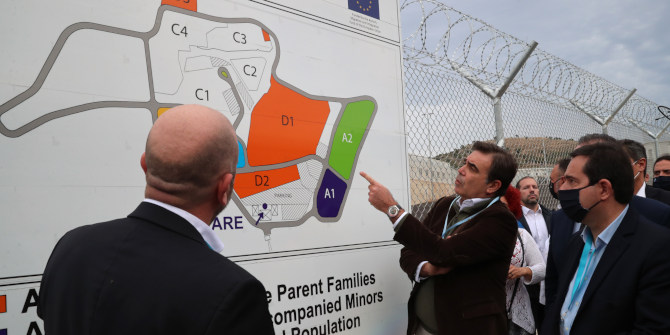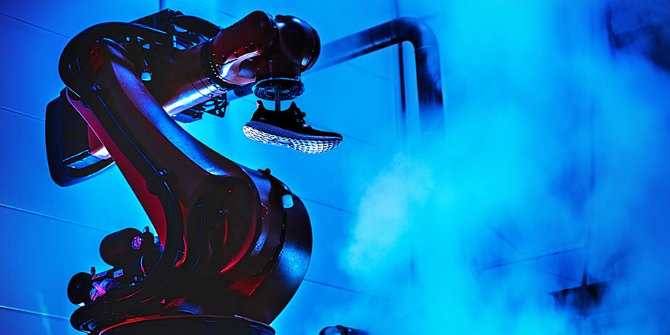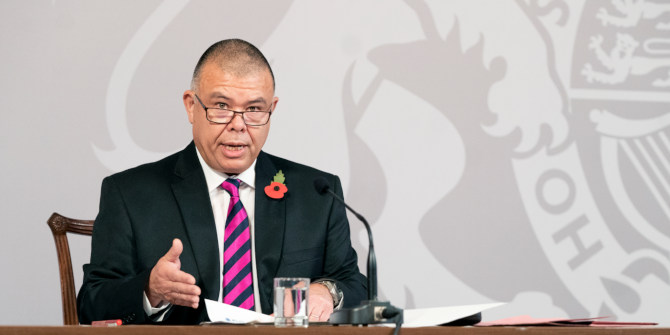A new alliance of the French left led by Jean-Luc Mélenchon – the Nouvelle union populaire écologique et sociale (Nupes) – will compete in the French legislative elections on 12 and 19 June. Philippe Marlière assesses what impact the formation of the alliance might have on the elections.
The launch of the Nupes has dramatically changed the political mood in France in the run up to the legislative elections on 12 and 19 June. Until then, the prospects for the left looked quite bleak. Despite Jean-Luc Mélenchon’s strong showing in the polls, the left had again failed to qualify for the second round of the presidential election. Disunited, the various parties of the left seemed destined for another crushing defeat in the legislative elections. Nupes now gives them hope.
Nupes stands for Nouvelle union populaire écologique et sociale. The coalition gathers together the main left-wing parties: the Parti socialiste (PS), Parti communiste français (PCF), Europe écologie les verts (EELV), as well as smaller parties such as Génération.s, Génération écologie, and the Nouveaux démocrates. Nouveau parti anticapitaliste (NPA), the only anti-capitalist party that was invited to join the coalition, opted out as it refused to be part of a coalition alongside the PS.
In the first instance, each party signed a bilateral agreement with La France insoumise, Mélenchon’s movement. On 19 May, all one-to-one agreements merged in a comprehensive platform containing 650 policy proposals. This is not the first time that the left in France has formed such a broad electoral coalition. There are four historic precedents: 1924’s Cartel des gauches (Socialists and Radicals); 1936’s Popular Front (Socialists, Radicals and Communists, although the latter did not join the government); 1972’s Common Programme (PS, PCF and Mouvement des Radicaux de Gauche) and 1997’s “Plural Left” (PS, PCF, Citizens’ Movement and the Greens).
The new alliance’s programme is of a radical reformist nature. It is in line with the radicalism of the Common Programme of the 1970s, although commentators have noted that it is less radical than the 1972 agreement as it does not call for a transitional break with capitalism. As Thomas Piketty put it, the united left has put “social and fiscal justice” back on the political agenda (its flagship policies roll back the retirement age to 60 and raise the minimum wage). The Nupes roadmap also sets out ecological planning and a “golden climate rule” designed to protect biodiversity, fight environmental pollution and reduce greenhouse gases.
Interestingly, members of the new alliance are quite open about policy disagreements within the coalition. There are indeed 33 “policy differences”: e.g. on Europe, where the Nupes is committed to “redirecting the course of European integration towards more social justice, better environmental policies, and to defending public services”. But each party’s stand on Europe is stated. La France insoumise is presented as the heir of those who fought and rejected the 2005 Constitutional Treaty and as a movement that might “disobey” EU law, should the EU prevent the Nupes from implementing its programme. Meanwhile, the EELV is said to “support a federal Europe” and the PS is “strongly committed to pursuing European integration”.
Programmatic diplomacy also applies to the sensitive topic of the war in Ukraine. In the run-up to the presidential election, the PS and EELV vehemently opposed the stances on Ukraine taken by La France insoumise and the PCF. They were particularly alarmed at Mélenchon’s pro-Russian views in the pre-war period. This said, Ukraine should not be a cassus belli for the Nupes.
The programme states that the coalition is committed to “defending Ukraine’s territorial integrity” and points to “Putin’s crimes”. This, on the whole, seems fine, but it is also terribly vague: how would a Nupes-led government actually defend Ukraine? The programme remains evasive on this important issue. Furthermore, there is no mention of the strong disagreements between the coalition partners with regards to NATO: La France insoumise thinks that NATO constitutes a major threat in the region and wants France out of it, whereas the PS is dedicated to NATO membership.
What led to the formation of the Nupes?
A rather unsuccessful “popular primary election” was organised in January to select a common left-wing candidate for the 2022 presidential election. Christiane Taubira, a former Justice Minister during François Hollande’s presidency, won it but she was soon abandoned by her supporters. Instead of uniting the left, Taubira’s ill-prepared and amateurish campaign was seen as bringing about further division to the left.
In the end, opinion polls were the actual primary election on the left. After a slow start, Mélenchon finished strongly, much like he did in the 2017 presidential election. He was narrowly defeated by Marine Le Pen for the second spot in the runoff. Mélenchon further personalised an election that is, by its nature, very personalised. On two occasions he has now run as a self-nominated candidate, while refusing to take party in a primary election for the left.
In both 2017 and 2022, Mélenchon benefitted from tactical voting. In the latest election, voters who envisaged voting for other left-wing candidates switched allegiance at the last minute and supported Mélenchon. Some even disliked Mélenchon or were not in agreement with some of his policies, yet they voted tactically in the hope they could avoid a rerun of the 2017 contest between Macron and Le Pen. Left-wing voters were desperate to avoid the left’s exclusion from the second round yet again.
When Mélenchon proposed an alliance to his left-wing rivals, he did so from a position of strength, after emphatically defeating all other left-wing candidates in the first round. This meant that he could impose the tempo and nature of the coalition talks. What is more, he managed to self-appoint himself as “Prime Minister in-waiting”, should the Nupes win the legislative elections. He even asked voters to “elect” him Prime Minister, a constitutional aberration since only the President can appoint the Prime Minister.
La France insoumise is very much the dominant force within the Nupes: with 325 candidates across France, Mélenchon’s movement accounts for just over 56% of the Nupes’ candidates. On 1 May, at the Nupes’ public launch in Aubervilliers, each left-wing leader was given some brief speaking-time. Mélenchon spoke last and his speech lasted almost two hours.
Interestingly, the Nupes represents a major tactical change for Mélenchon, who between 2016 and 2020 deliberately scorned the left and embraced a “populist” strategy. He unsuccessfully tried to federate the “people” beyond the traditional left-right divide. This did not work out to plan: during Macron’s first term, La France insoumise suffered from poor electoral results and the movement only managed to get a few party officials elected across France.
Mélenchon badly needed the Nupes to avoid being soundly defeated again by Macron’s party in the legislative elections (La France insoumise currently has 17 MPs against the 267 MPs belonging to Macron’s party). Yet the other left-wing parties also badly needed the alliance to salvage their parliamentary group. The PS, PCF and EELV fared so abysmally in the presidential election that there was a real risk that without such an agreement, they could lose virtually all their MPs.
This being said, what was initially a tactical retreat on the part of a weakened left has turned out to be a bit of a masterstroke. Voters are generally supportive of the agreement and there is now real hope the left might significantly increase its representation in the National Assembly, if not win the election outright. Ironically, the alliance might boost the ailing fortunes of the PS, which has been fighting for its survival over the past five years. The Nupes agreement gives the PS a chance to shift to the left and reconnect with its lost electorate. If it keeps left and manages to promote competent leaders, it might even recover lost ground and become a significant force again.
What next?
Three electoral scenarios can be envisaged at this stage. The first is that the Nupes will win an overall majority. This is possible but remains unlikely. Mélenchon would become Prime Minister in this scenario, and the Nupes would start to function as an umbrella parliamentary group (each party will keep its own parliamentary group within the Nupes).
The second scenario would be if the Nupes does not win an overall majority, but the left significantly increases its total number of MPs (which combined currently stands at 60). This would provide an incentive for the coalition to keep working together. Finally, it is possible the Nupes will be largely defeated, and only La France insoumise might increase its total number of MPs. This would test the resilience and strength of the alliance to the full.
At present, opinion polls suggest that the second of these scenarios – the Nupes significantly increasing its share of MPs but failing to win a majority – is the most likely of all. If the Nupes fails to win a majority, it would mark the end of front-line political activities for Mélenchon, as he will not be running for re-election as an MP.
It remains to be seen how the election will transpire, but for now, the Nupes has given hope to a weakened left by creating a new political dynamic capable of challenging Macron’s “faux centrism”. Political differences between coalition parties can be ironed out at least for the foreseeable future. They did not prevent successful left-wing coalitions in 1936, 1981 or 1997.
Nevertheless, one should not lose sight of the fact that the total left-wing vote in France sat at around 30% at the end of Macron’s first term. In comparison, right-wing and far right votes total more than 60%. This shows there is no outright left-wing majority in France at present and provides reason to temper expectations about what the Nupes can achieve.
Note: This article gives the views of the author, not the position of EUROPP – European Politics and Policy or the London School of Economics. Featured image credit: Rue89 Strasbourg (CC BY-NC-SA 2.0)





